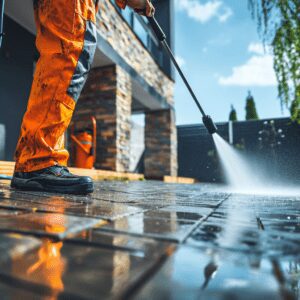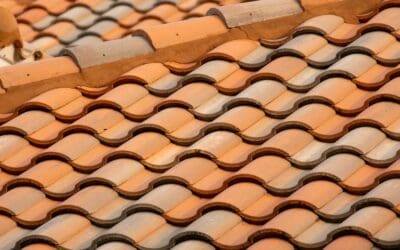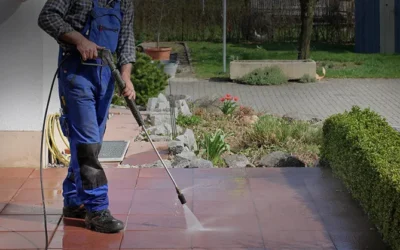A Comprehensive Guide to Preparing Your Property for Pressure Washing

Did you know improper preparation can diminish the effectiveness of pressure washing your property? It’s true.
Preparing your property for pressure washing is just as important as the cleaning itself, but it’s an often overlooked step. From protecting your plants and pets to ensuring your property is easily accessible for the cleaning crew, each step in the preparation process is critical.
But don’t worry, we’re here to help you navigate this important process. Stay with us as we walk you through a comprehensive checklist to ensure your property is primed for a successful and efficient pressure washing.
Understanding Pressure Washing
So, what are the basics of pressure washing that you need to understand?
First, pressure washing enhances your property’s curb appeal and prevents the growth of algae and moss. It’s crucial to start with the home exterior and clean the walls, sidings, windows, decks, patios, roofs, gutters, and other surrounding areas.
Pressure washing techniques vary depending on the area you’re cleaning. When pressure cleaning windows, exercise caution and use a low-pressure setting to avoid damage. Using high pressure on delicate surfaces is a common mistake, leading to unwanted damage.
Decks and patios, on the other hand, can handle a higher pressure. Pressure washing these areas removes dirt, spills, pet dander, and dust from crevices, making them ready for summer use.
Hiring a professional for pressure washing is a smart move. It ensures optimal results and minimizes the risk of property damage and personal injury.
Understanding these basics of pressure washing can help you prepare your property effectively while avoiding common pitfalls. It’s all about knowing the right techniques and avoiding common mistakes.
Evaluating & Preparing Your Property for Pressure Washing
Before you start pressure washing, examine your home’s exterior closely to pinpoint areas that need attention. Start by assessing surfaces for signs of algae, mold, dirt, or grime. These unsightly spots are often found on walls, sidings, windows, decks, patios, and roofs and require thorough cleaning.
Next, move on to identifying problem areas around your property. Driveways, walkways, outdoor furniture, fencing, and play areas are all potential candidates for pressure washing. A keen eye will spot the often overlooked buildup that can make a significant difference once cleaned.
Don’t forget to check for potential hazards. Loose items and outdoor electrical outlets should be noted and protected. You’ll also need to consider the presence of plants or pets that may need to be relocated during the cleaning process.
Pre-Cleaning: What to Do
When preparing your property for pressure washing, ensuring all windows and doors are tightly closed to keep water out is crucial. Pre-cleaning is an essential part of this process and requires careful time management.
Start by sealing small holes in window sills and removing shutters to access and clean the areas underneath. This step helps you avoid water leakage and potential damage.
Another important aspect of pre-cleaning is choosing the right cleaning solutions. Avoid harsh or corrosive solutions that may damage your property. Opt for eco-friendly, mild detergents that will effectively clean without causing harm.
Next, focus on outdoor lighting fixtures. Avoid spraying water directly onto them during the pressure washing to prevent damage. Instead, clean them gently by hand.
Safety Measures to Implement

After taking care of the pre-cleaning steps, paying close attention to safety measures when you’re ready to start pressure washing is important. The importance of safety gear can’t be overstated. Always wear appropriate protective gear such as goggles, gloves, and non-slip footwear. These items protect you from hazards such as flying debris and slippery surfaces.
Ensure the pressure washer is on a stable and level surface. This prevents potential accidents like tipping or falling. Also, keep a safe distance from electrical outlets, power lines, and outdoor fixtures. Water can pose hazards if it comes into contact with them.
Avoid pressure washing on ladders or elevated surfaces. The high pressure can cause you to lose balance and fall. Before you begin, familiarize yourself with the pressure washer’s operation manual and safety instructions. This knowledge can prevent mishaps and injuries.
Protecting Your Plants and Pets
While ensuring your equipment is ready, remember to safeguard your plants and pets during the pressure washing process. Your green friends need protection, too, so start by covering them with plastic sheeting or a tarp. This prevents any harsh chemicals from damaging them. For added caution, water your plants before the wash. This minimizes the impact of cleaning solutions on them.
Now, let’s talk about pet safety measures. Keep your furry friends indoors or in a safe area away from the pressure washing. The noise and water pressure may scare them or potentially cause harm.
Also, consider using plant-friendly cleaning solutions. These are less likely to harm your garden if they come into contact with your plants. After the pressure washing, rinse your plants and garden thoroughly. This removes any residue and helps keep them healthy.
Just as you prepare your property and check your equipment, it’s crucial to take these steps to protect your plants and pets. It ensures a safe and efficient pressure-washing process for everyone involved.
The Role of Professional Services

In considering a pressure washing project, you might find that hiring a professional service can provide optimal results and significantly reduce potential risks. The benefits of hiring professionals are plentiful; they come equipped with skilled expertise, adherence to safety regulations, and proper insurance coverage for any unforeseen accidents or damage. This can be a cost-effective solution when you factor in the potential costs of doing it yourself, such as equipment rental, or damage from improper use.
But don’t just hire the first service you come across. Do your homework. Check reviews and licensing to gauge the quality and reliability of their work. A reputable pressure washing company will be transparent about its experience, references, and equipment. Don’t be shy about asking for guarantees and insurance coverage information.
Post-Cleaning: Care and Maintenance
After you’ve enlisted professional help for pressure washing, your focus should shift to the care and maintenance of your property post-cleaning. A clean property looks good and needs less repair, ensuring its longevity. Remember, preventing damage is as crucial as cleaning itself.
Here are some essential tips for long-term maintenance:
- Apply a protective sealant to all exterior surfaces. This helps maintain cleanliness and prevents future buildup.
- After pressure washing, inspect all windows, doors, and seals for potential water damage or leaks.
- Keep gutters and downspouts clean. Regular cleaning prevents clogs and ensures proper drainage.
- Check for signs of pest infestation or nesting in areas that were pressure washed.
- Schedule regular maintenance. This keeps your property looking its best after pressure washing.
If the thought of preparing your property for pressure washing feels overwhelming, or if you simply prefer to ensure it’s done with professional precision, consider reaching out to Bradenton Pressure Washing. Founded in 2018, our team at Bradenton Pressure Washing is dedicated to providing top-notch services including House Exterior Washing, Roof Soft Washing, Paver Cleaning, Driveway Cleaning, Paver Sealing, and Commercial Exterior Cleaning. Serving Manatee County and Sarasota County, FL, we pride ourselves on delivering satisfaction-guaranteed services with free estimates.
Remember, a clean property is not just about aesthetics; it’s about maintenance, safety, and preserving the value of your investment. Let Bradenton Pressure Washing be your partner in achieving that.



